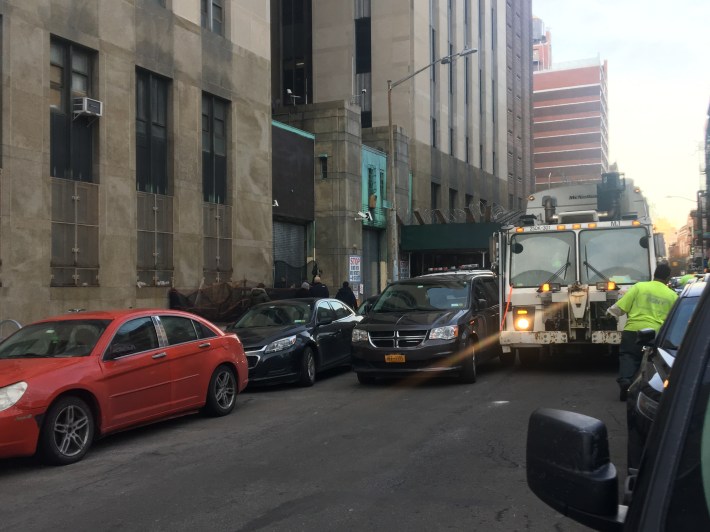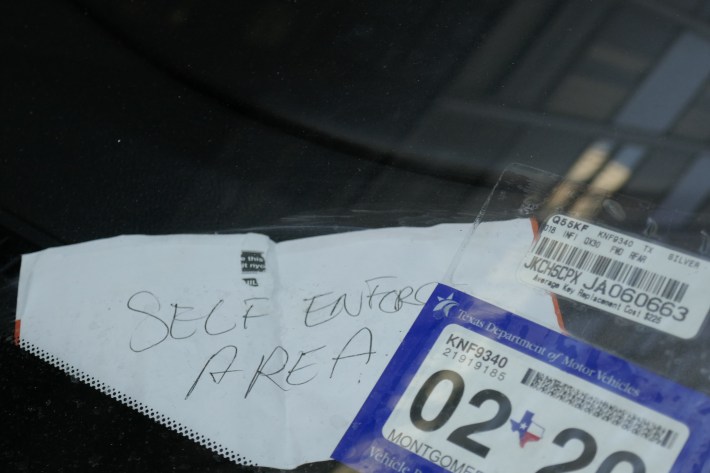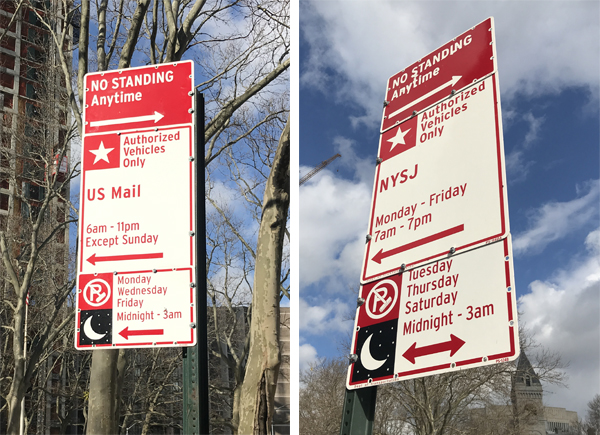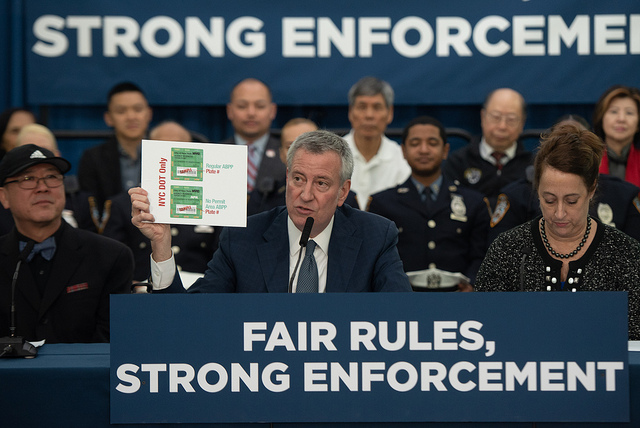So much for the long-awaited placard crackdown!
Mayor de Blasio announced on Thursday that the city won't reduce the number of city-issued parking passes — in fact, the mayor's plan for solving the intractable placard parking crisis calls for the expenditure of millions of taxpayer dollars to build or lease parking lots for tens of thousands of police officers and firefighters who currently park wherever they want with their city-issued windshield passes.
Even as rampant illegal parking by government employees harms public safety, exacerbates congestion, and betrays public trust, de Blasio's concern appeared to be limited to the prevalence of untold numbers of fraudulent permits. Speaking to reporters in placard-plagued Chinatown on Thursday afternoon, he lambasted illegal placard parkers, but played down the inherent inequity baked into the existence of placards, which allow 125,000-140,000 city cops, firefighters, teachers and other public employees to have a place to park their cars when they drive to their jobs.
"We will purchase parking lots, we will lease parking lots, parking garages — whatever it takes ... so that our firefighters, our police officers, our EMTs actually have a place that they know they can park," the mayor said, suggesting wrongly that the city is obligated to provide parking for uniformed officers, many of whom commute from outside the city. "Many officers feel they have no choice [but to drive to work]. ... This is a very worthy investment."
Pressed by Streetsblog on the logic behind that proposal, the mayor argued that uniformed officers are owed parking privileges unavailable to the rest of the city's residents.
"There’s a lot of our officers that are coming in from very far away for objective reasons — the cost of housing in the city, etc.," he said. "Going forward, can we find ways to encourage carpooling and incentivizing carpooling? I think we can. You know, are there situations where people can use mass transit more? Sometimes, but other times, not realistically, and not with the long hours they work and the long commutes."
The mayor could, of course, pay city workers more or require them to live within the five boroughs, but, instead, he championed their supposed need for free parking at their workplace — a privilege that allows them to live differently, and farther from, the people they serve.

"They deserve special consideration," the mayor said, citing Detective Brian Simonsen, who commuted 80 miles each day from Suffolk County before being killed in the line of duty last week. "If people were only using their placards the way they’re supposed to, we would have an entirely different situation."
Not entirely different. Across the city, public officials and imposters get away with illegal and unsafe parking in front of fire hydrants and crosswalks, in bike lanes and bus lanes — and even on sidewalks — all thanks to parking placards, which are distributed in the tens of thousands. In the last three years, however, a growing chorus of citizen watchdogs, media outlets, and elected officials have bemoaned the over-proliferation of placards and their impact on both public safety and traffic congestion.

The multi-pronged strategy unveiled on Thursday is the mayor's second attempt to address the scourge of parking placards, the most-recent coming after his administration agreed to dole out placards to the city's 50,000 public school teachers. Thursday's announcement offered a short-term approach that includes:
- Creating a paltry 10-agent unit at the Department of Transportation dedicated to enforcing illegal placard parking in known hotspots such as Lower Manhattan and Downtown Brooklyn.
- Imposing a three-strikes-and-you're-out rule on placard-holders, revoking the placard if a recipient is found illegally parked three times.
- Creating a $250 penalty for illegally parking with a placard, though the city believes will require authorization from Albany.
- Initiating a "placard census," focused on fraudulent placards and executed by the mayor's Street Conditions Observation Unit.
Simultaneously, DOT is testing out barcode-adorned placards, which should be harder to forge and impossible to transfer from one vehicle to another.
In the longer term, by 2021, the city hopes to harness license-plate-recognition technology for all city parking spots. That tech will allow traffic enforcement agents to determine whether placards are actually being used for specific office business, or just to ensure a parking spot at work or the grocery store, according to Deputy Mayor Laura Anglin, who gave few details when pressed whether enforcement agents would still be able to look the other way at their placard-abusing fellow officers — a common problem today.
The $52-million system will "eventually link parking meters, hand-held enforcement devices and license plates," the city said in an accompanying statement.
"You're just going to read the license plate. That license plate will tell us if you're allowed to be parked there and, if not, a ticket will be generated automatically." Anglin said, though she was later contradicted by the mayor, who was also shaky on the details of how the human enforcement element would be removed. "If it's deemed that they're not supposed to be there, they can go to an appeals process to show that they were supposed to be there."
One major flaw in the mayor's announcement? Placards issued by state and federal agencies were not addressed. In fact, the city doesn't even know how many of those placards are in circulation. DOT claims the total number of parking placards — including handicapped placards and placards issued by DOT, NYPD, and the Board of Education — is 125,500. Multiple federal and state agencies — federal courts, the Federal Reserve, the State Attorney General's office, the MTA, etc. etc. etc — issue placards that the city does not control. Those agencies get DOT-issued signs setting aside curbside space for authorized vehicles — but it's anyone's guess who does the authorizing.

The largest problem? The city has no intention of curtailing the continued expansion of the parking placard regime, which contributes heavily to its growing congestion problems. Government workers are less likely than other city residents to own cars, but have become more likely to commute by car into the Central Business District of Manhattan because of their placard-guaranteed parking privileges. And nothing in the mayor's announcement Thursday will change that. In fact, he's only going to make it easier for city workers to use their cars to get to work.
“It's about enforcement, it's also about city government believing they need to be an entitled parking class," said Bike New York Advocacy Director Jon Orcutt, a former DOT official under Mayor Bloomberg, one mayor who actually reduced the number of city-issued placards. "The rest of the city’s organizations and companies all function with far fewer cars. City government can use transit and walk and bike just like the rest of us.”
In anticipating of the mayor's announcement, Streetsblog reviewed the history of placard abuse, and offered tips from other cities. Perhaps the mayor should read it.






